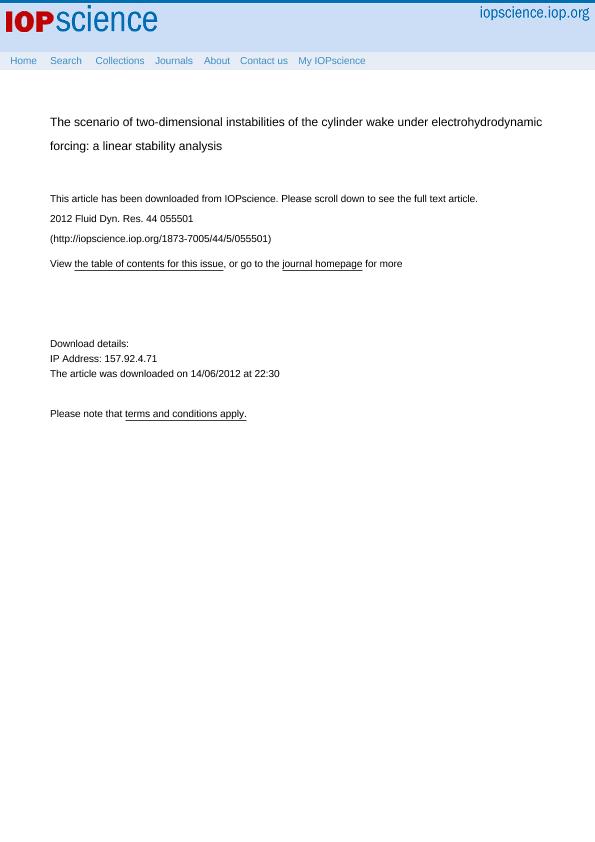Mostrar el registro sencillo del ítem
dc.contributor.author
D'adamo, Juan Gastón Leonel

dc.contributor.author
González, Leo M.
dc.contributor.author
Gronskis, Alejandro

dc.contributor.author
Artana, Guillermo Osvaldo

dc.date.available
2023-05-09T13:14:16Z
dc.date.issued
2012-06
dc.identifier.citation
D'adamo, Juan Gastón Leonel; González, Leo M.; Gronskis, Alejandro; Artana, Guillermo Osvaldo; The scenario of two-dimensional instabilities of the cylinder wake under electrohydrodynamic forcing: A linear stability analysis; IOP Publishing; Fluid Dynamics Research; 44; 5; 6-2012; 1-20
dc.identifier.issn
0169-5983
dc.identifier.uri
http://hdl.handle.net/11336/196765
dc.description.abstract
We propose to study the stability properties of an air flow wake forced by a dielectric barrier discharge (DBD) actuator, which is a type of electrohydrodynamic (EHD) actuator. These actuators add momentum to the flow around a cylinder in regions close to the wall and, in our case, are symmetrically disposed near the boundary layer separation point. Since the forcing frequencies, typical of DBD, are much higher than the natural shedding frequency of the flow, we will be considering the forcing actuation as stationary. In the first part, the flow around a circular cylinder modified by EHD actuators will be experimentally studied by means of particle image velocimetry (PIV). In the second part, the EHD actuators have been numerically implemented as a boundary condition on the cylinder surface. Using this boundary condition, the computationally obtained base flow is then compared with the experimental one in order to relate the control parameters from both methodologies. After validating the obtained agreement, we study the Hopf bifurcation that appears once the flow starts the vortex shedding through experimental and computational approaches. For the base flow derived from experimentally obtained snapshots, we monitor the evolution of the velocity amplitude oscillations. As to the computationally obtained base flow, its stability is analyzed by solving a global eigenvalue problem obtained from the linearized Navier-Stokes equations. Finally, the critical parameters obtained from both approaches are compared.
dc.format
application/pdf
dc.language.iso
eng
dc.publisher
IOP Publishing

dc.rights
info:eu-repo/semantics/openAccess
dc.rights.uri
https://creativecommons.org/licenses/by-nc-sa/2.5/ar/
dc.subject
Flow control
dc.subject.classification
Ingeniería Mecánica

dc.subject.classification
Ingeniería Mecánica

dc.subject.classification
INGENIERÍAS Y TECNOLOGÍAS

dc.title
The scenario of two-dimensional instabilities of the cylinder wake under electrohydrodynamic forcing: A linear stability analysis
dc.type
info:eu-repo/semantics/article
dc.type
info:ar-repo/semantics/artículo
dc.type
info:eu-repo/semantics/publishedVersion
dc.date.updated
2023-05-05T17:17:28Z
dc.journal.volume
44
dc.journal.number
5
dc.journal.pagination
1-20
dc.journal.pais
Reino Unido

dc.journal.ciudad
Londres
dc.description.fil
Fil: D'adamo, Juan Gastón Leonel. Universidad de Buenos Aires. Facultad de Ingeniería. Departamento de Ingeniería Mecánica. Laboratorio de Fluidodinámica; Argentina. Consejo Nacional de Investigaciones Científicas y Técnicas; Argentina
dc.description.fil
Fil: González, Leo M.. Universidad Politécnica de Madrid; España
dc.description.fil
Fil: Gronskis, Alejandro. Universidad de Buenos Aires. Facultad de Ingeniería. Departamento de Ingeniería Mecánica. Laboratorio de Fluidodinámica; Argentina
dc.description.fil
Fil: Artana, Guillermo Osvaldo. Universidad de Buenos Aires. Facultad de Ingeniería. Departamento de Ingeniería Mecánica. Laboratorio de Fluidodinámica; Argentina. Consejo Nacional de Investigaciones Científicas y Técnicas; Argentina
dc.journal.title
Fluid Dynamics Research

dc.relation.alternativeid
info:eu-repo/semantics/altIdentifier/doi/http://dx.doi.org/10.1088/0169-5983/44/5/055501
Archivos asociados
